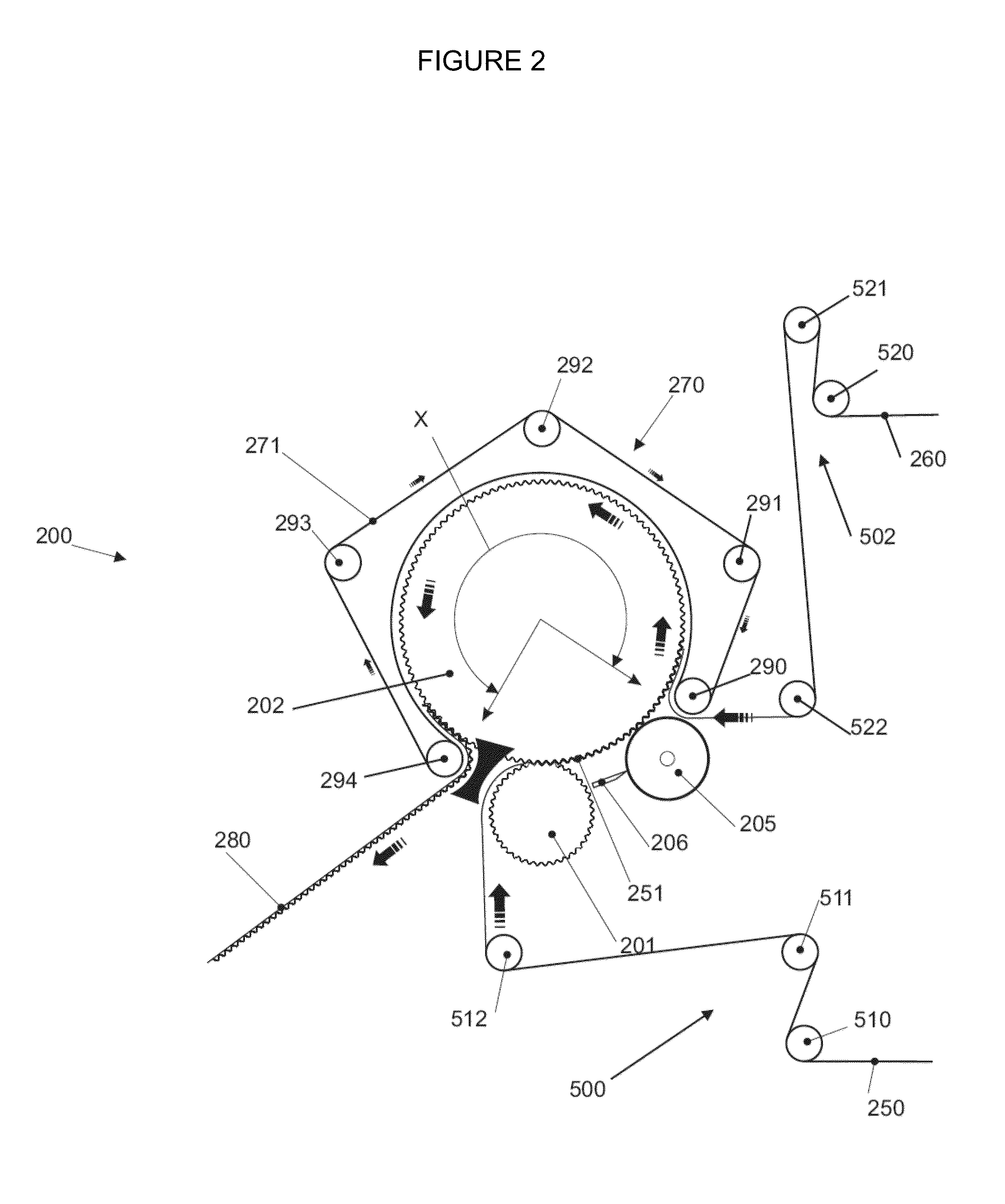Method and apparatus for forming corrugated board
a corrugated board and surface technology, applied in the direction of soldering apparatus, manufacturing tools,auxillary welding devices, etc., can solve the problems of limited contact time, reducing the value of unusable marks on the surface of the liner paper, so as to reduce the energy requirements and shorten the bonding time. , the effect of significant bonding tim
- Summary
- Abstract
- Description
- Claims
- Application Information
AI Technical Summary
Benefits of technology
Problems solved by technology
Method used
Image
Examples
example 1
[0276]To calculate the rate of production for a 1.6 m diameter second corrugating (i.e. large) roller where the endless belt extends 76% around the second roller applying the new formula of the present invention RP=DHT / BT this equates to a RP (rate of production) of 0.76(π1.6) / 0.05 which equals a rate of production of 76 m / min wherein 0.05 minutes is a 3 second bond time. This rate of production is significantly slower than that calculated by the applicant in WO2009 / 000085.
example 2
[0277]If a manufacturer requires a rate of production which is 143 m / min using an adhesive having a BT of 0.033333 min (i.e. 2 s) the diameter of the second corrugating (i.e. larger) roller applying the new formula of the present invention DHT can be represented as 0.93×(π2r) and the diameter can be calculated from DHT=RP·BT would be (143×0.033333). Then to get the diameter we rearrange the equation 0.93×(π2r)=(143×0.033333) so that 2r (i.e. the diameter)=((143×0.033333) / 0.76) / n which equals a diameter of 2 m.
example 3
[0278]If we wanted to calculate the rate of production for a 2 m diameter roller wherein the BT is 0.05 min (i.e. 3 s). Applying the formula RP=DHT / BT 0.93(π2) / 0.05 which equals 116 m / min.
[0279]In practice a diameter of 2 m is at or near the limit at which corrugated cardboard can be created via a pair of intermeshing corrugating rollers: such as described herein, shown in FIG. 2 or as described in the applicant's previous PCT Application WO2009 / 145642. One reason why in practice it is not possible to have a large corrugating roller with a diameter significantly larger than 2 m (for instance a 2.5 m, 3 m or greater diameter roller) is due to the increased weight of such a roller making it difficult to lift and move particularly when it comes to construction and maintenance and repair of such a large roller. Furthermore, the increased weight of a roller with a diameter greater than 2 m requires significantly more energy to rotate the roller and thus increases the cost of production. ...
PUM
| Property | Measurement | Unit |
|---|---|---|
| operating temperatures | aaaaa | aaaaa |
| diameter | aaaaa | aaaaa |
| pressure | aaaaa | aaaaa |
Abstract
Description
Claims
Application Information
 Login to View More
Login to View More - R&D
- Intellectual Property
- Life Sciences
- Materials
- Tech Scout
- Unparalleled Data Quality
- Higher Quality Content
- 60% Fewer Hallucinations
Browse by: Latest US Patents, China's latest patents, Technical Efficacy Thesaurus, Application Domain, Technology Topic, Popular Technical Reports.
© 2025 PatSnap. All rights reserved.Legal|Privacy policy|Modern Slavery Act Transparency Statement|Sitemap|About US| Contact US: help@patsnap.com



